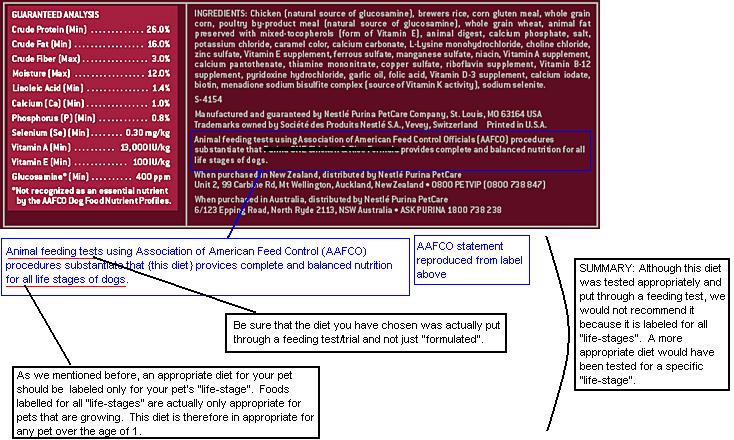With So Many Choices, What Do I Feed My Pet?
Over–the-counter foods, prescription-therapeutic foods, canned, dry, raw, high-protein, low-protein, kitten/puppy, adult, active adult, senior, overweight, giant breed, small breed, purebred, mutt, gourmet designer brands, natural, organic, vegetarian…Whew, no wonder pet owners are confused. In addition to these choices, there is a lot of misinformation about pet food diets floating around out there.
Here’s a quick quiz on pet food diets. See how you do.
True/False: (Answers Below)
1) All pet foods are the same. (True/False)
2) The first ingredient in the list should be a meat because that means it is the largest component of the diet. (True/False)
3) Corn is used just as filler. (True/False)
4) By-products are used as filler and have no nutritional value. (True/False)
5) Raw foods help pets live longer. (True/False)
Answers:
1) False. Many pet foods claim to be appropriate for all pets – no matter their age, lifestyle or weight. But in reality, your pet has very special nutritional needs, and only precisely balanced nutrition – nutrition that contains neither excessive nor deficient amounts of key nutrients – can meet those needs.
2) False. Although meat is important, the other ingredients in the food are just as important and necessary for a nutritionally balanced diet. Ingredients are listed in descending order by weight before natural moisture is taken out of the ingredient. Take out the moisture, and the “meat” will no longer be at the top of the list.
3) False. Corn is a natural and wholesome ingredient loaded with highly digestible carbohydrates for ready energy, essential fatty acids for healthy skin coat, quality proteins for muscle and tissue growth, as well as beta-carotene, vitamin E and gluten – nature’s antioxidants.
4) False. A by-product is simply something produced in the making of something else. For example, vitamin E is a by-product of soybean production. Chicken liver and lamb meal are both considered by-products. High-quality meat meal by-products and by-product meals composed of internal organs are highly digestible and do not contain excessive minerals like many less expensive meat meals do.
5) False. Feeding raw meat, eggs and bones can be dangerous for your pet due to the excessive levels of nutrients like protein, calcium and phosphorus. Pets eating these foods are also at an increased risk for fractured teeth, gastrointestinal perforation, and exposure to bacteria such as E. coli and salmonella. Both the Centers for Disease Control and the Companion Animal Parasite Council recommend owners avoid feeding raw diets to their pets
How do I know whether the diet I am feeding is good for my pet?
Unfortunately, there are countless pet food companies out there – many of them making false claims about their diets. Although companies are required to follow certain standards regarding the nutritional quality of their diets, there are only limited regulations regarding the production of the diet itself.
It is not easy to differentiate a “good diet” from a “bad diet” without a thorough analysis of the ingredients and without questioning the specific company regarding the quality of ingredients and the processing of those ingredients. BUT there are steps you can take to assist you in selecting the best diet for your pet.
Guidelines
Talk to your veterinarian.
We can advise and make sure that your pet does not have any underlying medical conditions that require it to be on a specific prescription food.
Make sure that the diet is appropriate for you pet’s “life-stage” (see below) and size (large breed vs. small breed).
Many diets claim to be appropriate for “all life-stages”. In fact, they have been shown to be only appropriate for growing puppies and kittens. Older animals have very different nutritional requirements making these “all life-stage” diets quite inappropriate for them.
Life Stage I: Growth
Life Stage II: Maintenance
Life Stage III: Senior Management
Check that the nutritional quality of the diet was tested through a feeding trial.
This can be verified by checking the AAFCO statement which can be found on the back of any diet package. Here is an example of an AAFCO statement (in the blue box) from a diet that was tested appropriately but we still would not recommend it (see why below).

Look at your pet.
A good diet will produce a pet that is thriving and energetic. The pet will have a nice hair coat and skin. And the pet will enjoy the taste and texture of the diet.
Keep in mind that even the best diet can be undermined by the pet owner.
Feed your pet the appropriate amount based on your pet’s activity level. Obesity is one of the most common problems diagnosed in both cats and dogs. Beware of overdoing the treats. Many treats are full calories. Animals on therapeutic prescription diets may have restrictions on the types of treats allowed.
Avoid jumping between diets.
Doing so may lead to a finicky eater, digestive upsets, or make it difficult to determine if the pet has a food allergy. Choose a food your pet enjoys and is thriving on and stick with it.
It’s not always easy to know what’s best, but by keeping these guidelines in mind, you will be able to make an informed decision regarding your pet’s diet.
* Answers to the True/False questions courtesy of Hill’s Pet Nutrition



